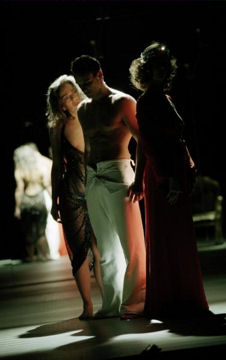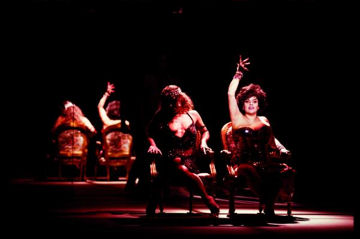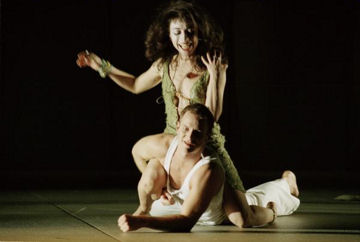Edinburgh International
Festival (1): Barrie Kosky Poppea
after Claudio Monteverdi, L’incoronazione di
Poppea
Production, actors and pit musicians from the
Vienna Schauspielhaus, Royal Lyceum Theatre,
Edinburgh, Scotland 13.8.2007 (MM)
Actors:
Melita Jurisic, Ruth Brauer, Beatrice Frey,
Barbara Spitz, Kyrre Kvam, Martin Niedermair,
Florian Carove
Musicians:
Barrie Kosky, Jörg Ulrich Krah, Aisha Bukayeva,
Linde Gansch-Härtel
Production:
Barrie Kosky - Director/ Music Director
Jörg Ulrich Krah and Barrie Kosky - Music
Susanne Wolf -Translation/Dramaturgy
Michael Zerz - Set Design
Alfred Mayerhofer - Costumes
Michael Zerz and Barrie Kosky - Lighting Design

Tragic dignity along with Platonic idealism long
flushed into a canal, Venice’s mid- seventeenth
century opera scene was real, the real having
everything to do with what turned the public on.
The Venetian audience was no doubt sexually quite
sophisticated, and luckily the senior citizens of
Britain must be even moreso as this experience was
needed to appreciate director Barrie Kosky’s
fantasy on Monteverdi’s last opera, The
Coronation of Poppea.
With only an occasional word of Italian to be
heard, the guttural utterances of German actors
were appropriately matched the guttural tones of
an orchestra of three cellos throbbing between the
legs of their players, all this mixed with the
lively innuendoes of worldly Cole Porter lyrics.
And not a singer in sight.
The curators of the Edinburgh festival must have
had some trepidation as this version from the
Vienna Schauspielhaus of Monteverdi’s last
masterpiece could only be perceived as a
centerpiece of the festival’s focus on the first
of the great Italian musical lyricists. Although
a synopsis of Poppea’s action could not be
found in the program booklet a sort of apology
could, this in the guise of a listing of director
Kosky’s weird sexual concepts for opera
productions in Austria and Australia. While we
all have come a long way and can handle most
anything thrown at us by now, the fear lingered
that the experience was going to be gross.

And of course it was, though it is hard to decide
if the grossness was Monteverdi’s opera itself -
the very nerve to create a theatrical fantasy on
an operatic masterpiece - or the compendium of
sexual deviations that was so gracefully inserted
into Monteverdi’s libretto. Amore was a Madame
whose pleasures by now have included those of the
table, her bejewelled fingers shooting sparks of
the je-ne-sais-quoi that ignite and tease
passions. Love had twisted Poppea’s young husband
Ottone into contortions, Poppea was an animal
shooting more sparks from her teeth and growls
from her mouth, Nero’s body and mind revealed
indulgences that transcended the primitivism of
his costume, a piece of sparkling black fabric
that hung waist down like a pelt, matching that of
Poppea. Seneca appears as a deaf mute, an
inanimate statue, a masturbating voyeur.
These were actors whose entire physical, spiritual
and vocal presences embodied Monteverdi’s
characters. We soon understood that while they
were not singers, they would sing anyway, the
entire text as well as the inserted songs - both
Cole Porter’s and finally the magnificent
Monteverdi lament and love duet, the rejected
empress Ottavia using broken voiced harmonics and
squeaks, the triumphant Poppea twisting her low
predatory tones under the strange tenorial
innocence of Nero. Not opera or even ballad
singers, these actors were certainly instinctual
musicians.

The generic contemporary German stage box held but
two Louis XIV chairs that crashed silently from
time to time and a small bathtub that shot into
the space from time to time. Within this space
the whore Madame Amore guides Poppea to her goal,
rids Nero of Seneca in a blood bath, thwarts
Ottavia’s revenge and sends Ottone and his new
sweetheart Drusilla off into the sunset,
presumably to continue singing Cole Porter songs
to one another. This leaves Poppea and Nero
alone, sitting passively side by side, professing
love in this sudden emptiness. It is
empty, and for once we have truly felt
Monteverdi’s deep intuition that it is suffering
and not love that is the fun.
This evening of theatrical hyper-sophistication
never strayed too far from Monteverdi musically,
with L’incornazione di Poppea’s most
recognisable themes as well as subtle
distillations of Monteverdi’s musically elaborate
recitatives woven into composer Kosky’s musical
texture. Theatrically Poppea kept the
careful balances of tragicomedy even with or
perhaps because of the audacious mixing of Cole
Porter songs with Kosky’s music. These songs,
plus the use of the German language, an always
useful barroom piano, the throaty sounds of cello,
a greatly simplified love situation made a fine
cabaret opera, perhaps musically too sophisticated
for the larger theater public and theatrically too
sophisticated for the larger opera audience. It
was a perfect evening for Edinburgh’s festival
audience.
Unlike opera traditionally thought to be made of
individual performances, theater prides itself on
ensemble, thus no individual bows were taken (and
so no names are here written). In a
well-rehearsed simultaneous motion the actors
recognised the musical and theatrical creator of
the evening, Barrie Kosky who sat at the piano in
the orchestra pit.
Michael Milenski
Pictures © Nick Mangafas / Schauspielhaus
Michael Milenski is General Director Emeritus of
Long Beach Opera, California. He retired in 2004
after 25 years at Long Beach and his
current website
www.capsuropera.com tracks opera from
Genoa through the south of France to Barcelona.
Back
to the Top
Back to the Index Page

